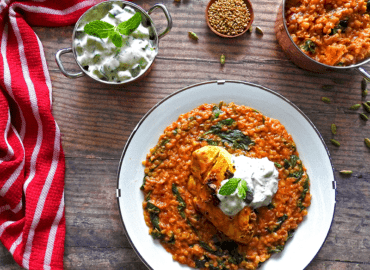*This post may contain affiliate links. Read my disclaimer here. While we may use affiliate links, we would never allow this to influence product listings or recommendations.
Feeling disheartened because that amazing curry recipe has turned out thin, watery and lacklustre? Look no further to learn how to thicken curry and turn that disappointing liquid into a luscious, rich and abundant gravy.
Before you jump ahead to trying all the various thickening methods below, it is also worth considering if the curry needs thickening. Not all curries are made equal. While most have a sauce that is thick enough to cling to the ingredients, they are also thin enough to dunk a buttery naan into. Some varieties of curry are also thinner than others, for example, Thai curries, which are very thin and soupy.
Convinced you need some extra thickening power? Read on to learn about the most popular methods to thicken curry and the pros and cons of each.

1. Reduce the sauce by increasing the heat
If you don’t want to faff around with adding extra ingredients to the process then this can be a quick and simple way to reduce excess liquid and bulk up the curry.
However, depending on the ingredients in the recipe this method can often reduce the amount of liquid, and not necessarily thicken the liquid much. It will also concentrate the flavours in the curry so is not ideal if you are already happy with the taste and strength.
How to do it
Increase the heat on the hob/stove and let the curry simmer or lightly boil until the liquid has reduced to the desired level. The length of time needed will depend on the volume of liquid and desired results.
2. Cornflour

Cornflour is an extremely popular thickening agent for curries, gravies, stews and many other things. It is perfect to use in sauces that need thickening and a little extra body.
It is not completely flavourless but when using it in a recipe with a host of strong spices and tastes, any flavour it adds will be negligible. Cornflour also stands up to high heat and being cooked for an extended period of time which makes it a great option.
How to use it
Use around 1 tbsp for every 250ml (1 cup) of liquid. Mix it with the same volume of water until you have a smooth slurry and then pour it slowly into the curry, stirring well.
Cornflour requires heat to activate so make sure that the liquid is hot enough. If you are using a slow cooker then you may need to temporarily transfer the curry to the hob to get the temperature high enough.
You can also check out this post to learn more about how to use cornflour.
3. Increase the volume of thickening ingredients
Depending on the type of curry you are making, you can probably pinpoint something which is already in the list of ingredients to increase the volume of, which will have a thickening result. A few options include:
- Tomato puree (or paste if you are in the US). If the curry you are using has a tomato base then you can add an extra tablespoon or so to the sauce to thicken it up.
- Yogurt. If the sauce is creamy or already contains yogurt, then this can work wonders to thicken the sauce. Be careful as yogurt can split if it’s added to very hot sauces. To avoid this use room temperature yogurt and temper it by combining it with a little curry sauce in a bowl before adding it to the pan. You can also whisk it with a teaspoon of cornflour first which helps to prevent it from curdling and adds even more thickening power to the dish.
- Cream or coconut milk. Thick cream or coconut milk can also help add more bulk to the sauce. Although, if you opt for coconut milk and it’s not already contained in the recipe then bear in mind that it will add a coconut flavour to the dish.
Arrowroot
Arrowroot is used in a similar way to cornflour and should also be added towards the end of cooking.
It has virtually no taste so you don’t need to worry about it adding any unwanted extra flavour. However, it doesn’t hold up to heat as well as cornflour, so you should only cook it for 1-2 minutes after adding and then remove the curry from the heat.
How to use it
Use 2 tsp of arrowroot powder for every 250ml/1 cup of liquid to thicken. Mix it with an equal amount of water until you have a smooth slurry. Then pour it into the curry, slowly. Stir through before removing the curry from the heat.
Now you know how to transform a thin curry into a gloriously thick masterpiece, why not try one of these great recipes:










